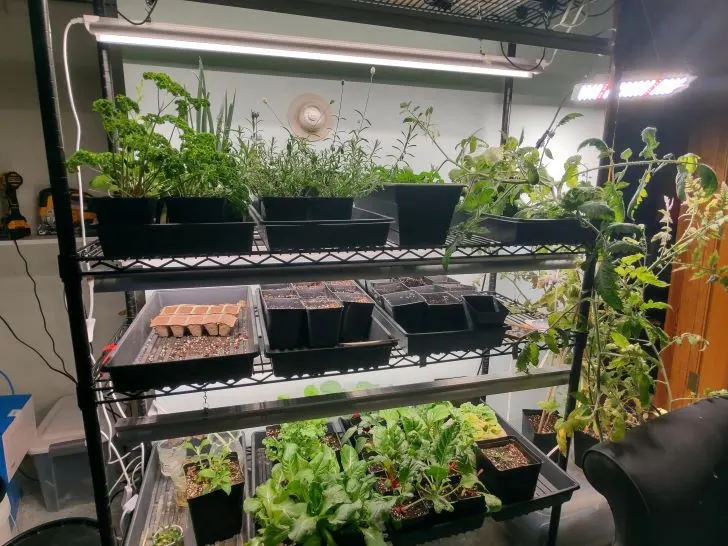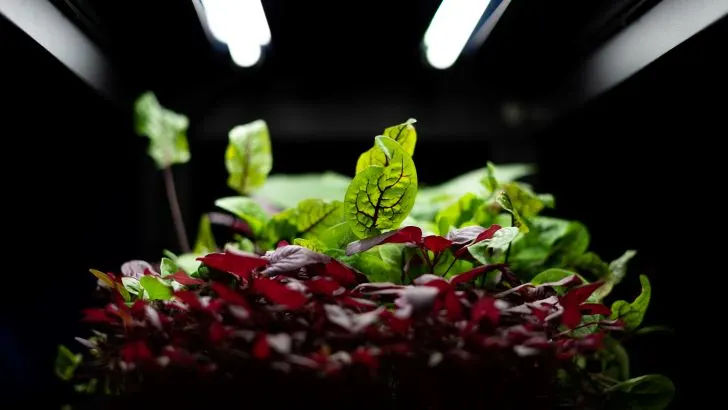Growing indoor vegetables sure sounds mesmerizing, but it can be a bit challenging—especially if you are new to gardening.
Most of the time, our indoor space is all occupied by our houseplants, so we don’t have any room left with sunlight availability for growing any indoor vegetables. It could be a bit daunting to grow indoor vegetables without sunlight.
So, what’s the solution?
The answer is artificial grow lights!
Artificial grow lights have massively influenced indoor gardening by allowing us to grow plants in areas without sunlight availability. Nowadays, we can grow vegetables and start our seedlings in our homes even if we don’t have access to natural sunlight.
Today, in this article, we will see how to grow vegetables indoors without sunlight.
This guide covers everything from selecting the appropriate gear to setting up your own indoor vegetable garden.
Let’s get straight into it!
Indoor Vegetable Garden with Gardyn!
Most of us don’t want the hassle of setting up an indoor garden from scratch.
Let me present to you Gardyn’s indoor vegetable garden.
Gardyn’s indoor vegetable gardens, built with patented Hybriponics® technology, let you grow 30 different large plants year-round in only a 2 sq. ft. space.
Equipped with an AI assistant, your indoor vegetable garden will receive the best and adapted plant care to deliver you the freshest and most nutrient-rich fruits and vegetables. It’s good for you, it’s good for your wallet, and it’s good for the planet.
So, what are you waiting for? Make your indoor growing system with Gardyn.

Setting up an Indoor Garden!
Let’s start by choosing the best location and equipment for your indoor garden.
First of all, if you don’t have any indoor houseplants lying around your house, you can use the empty window sills to grow your veggies. South-facing windows are best for growing vegetables because they receive plenty of sunlight throughout the day.
On the other hand, if you don’t find any place with sunlight accessibility, go for a place where you can set up an indoor garden. It can be as small as a square foot or as big as a room. It depends on what you want to grow—if you’re going to grow microgreens or herbs, a small place like a tabletop will work well.
That aside, let’s see what you’ll need to set up your indoor vegetable garden.
Containers
Different types and sizes of containers are suitable for different kinds of vegetables.
For example, leafy greens and herbs can grow well in shallow pots or window boxes, while root crops and fruiting vegetables need deeper pots or buckets to accommodate their roots and support their weight.
Moreover, ensure that the containers you choose to grow your indoor vegetables have drainage holes at the bottom to allow maximum water drainage and prevent waterlogging and root rot.
Lastly, grow each vegetable in an individual pot to avoid overcrowding.
Potting Mix
The second important thing to consider is the potting mixture.
Most gardeners prefer making their own potting mix so that they can tailor it to their specific needs. As a general rule of thumb, your potting mixture should be lightweight, nutritious, and well-draining.
However, you can also prefer store-bought potting mixes for growing indoor vegetables.
Just make sure it is free from contaminants and provides good drainage.
Grow Lights
Coming on to the most crucial part; the grow lights.
If you don’t know already, there are a ton of artificial grow lights on the market to choose from, and people often get confused about whether they are buying the right lights.
To make it simpler for you, here are a few things to consider before buying grow lights:
Shape and Size
It’s essential to choose the shape and size of your grow lights according to the arrangement of your indoor vegetable garden.
Ideally, you’d want to position the light directly above your seedlings.
A single light bulb will work if you are just growing one tray of seedlings—especially if it is supplemented with natural light as well. However, you’ll need clip-on rods or tube lights in a more extensive setup to ensure uniform coverage for multiple trays.
Technology
Next, you need to look at the technology.
- LED Grow Lights: Most people nowadays use LED grow lights to supplement their indoor gardens. The reason is pretty straightforward; LED lights come in various shapes and sizes, are energy-efficient, are long-lasting, and provide plants with a wide range of the photosynthetic active radiation spectrum.
- Fluorescent Tubes: Using tube-shaped fluorescent lights is also a good option for growing indoor vegetables. These lights are best for growing leafy vegetables and herbs as they flourish under blue light. Fluorescent tubes can easily fit into specialized fixtures but are less efficient than LED light bulbs.
- Compact Fluorescent Lights (CFL): Due to their compact design, CFLs are best for growing vegetables in small settings. These lights increase the day length by giving the plants extra light. CFLs are energy efficient as they produce less heat than traditional fluorescent lights and provide the light wavelengths that plants need to thrive.
- High-Intensity Discharge Lights: HIDs are primarily used in plant nurseries and greenhouses to grow maturing edible plants. They are excellent for large-scale setups because of their raw power. However, they are expensive, less efficient, and produce heat.
Let’s now talk about the quality of light.

Photosynthetic Active Radiation (PAR)
PAR, or Photosynthetic active radiation, is part of the light’s wavelength that the plants absorb and utilize for photosynthesis and growth.
The spectrum ranges from 400–700 nm.
The blue side of the spectrum is suitable for growing seedlings and leafy vegetables, while the red side of the spectrum is better for growing fruits and flowers. Therefore, before buying your grow lights, check the labeling to see what range of radiation spectrum it provides.
Light Intensity
Lastly, you’ll need to consider the light intensity.
Light intensity is measured in PPF (photosynthetic photon flux), PPFD (photosynthetic photon flux density), and foot candles.
Higher values of these measures mean higher light intensity.
Higher light intensity is excellent for starting early seedlings or maturing plants that are unable to receive natural sunlight to supplement their growth and development.
Vegetable Seeds
It’s better to start your indoor vegetable garden with seeds.
You might think using plant cuttings will give you a head start, but that’s not true! If you plant cuttings from your outdoor garden, most of them won’t succeed because they won’t adapt to the indoor environment.
Select the Right Vegetables
As you learn how to grow vegetables indoors without sunlight, you should know what types of vegetables are best for growing indoors.
- You’ll mostly find people growing microgreens, herbs, and leafy greens indoors. They don’t require much space and can easily be grown under low-light conditions.
- On the other hand, you can also grow radishes, carrots, tomatoes, cucumbers, beans, and peppers in your indoor garden—they’ll just need a bit more support.
That’s all you need to know about the types of veggies you can grow. So, feel free to try things out of the box.
Water
Using room-temperature tap water or rainwater to water your plants is best. You can also use distilled water, but it lacks essential minerals. Contrarily, softened water or hard water are not good for plants because they contain excess salt and minerals.
Fertilizer
It’s best only to use organic fertilizers for growing vegetables.
You can use anything from compost, fish emulsions, worm castings, or seaweed extract, as they contain essential nutrients and beneficial microorganisms for the plants to make them flourish at their peak potential.
A general rule is to fertilize your plants monthly during the growing season.
How to Grow Vegetables Indoors Without Sunlight?
Once you have everything set up, the rest is pretty straightforward.
1. Set up Your Containers and Grow Lights
Once you have chosen a place to grow your indoor vegetables, you must set it up.
Start by adding a frame to the scene; a tabletop will work just as well! You only need something to support your plant containers and the grow lights. (You might need some handicrafts and zip ties to arrange everything in place.)
Here’s a video guide for you:
After setting up the containers and grow lights, it’s time to plant the seeds.
2. Plant the Seeds
First, fill the pots, containers, or trays with the potting mixture. After that, plant 2–3 seeds in each container; see the planting depth on the packaging. Secondly, provide your plants with good growing space.
Visit here for a chart showing the growing area needed for different vegetables.
3. Water and Lighting
Once the seeds are planted, make sure to water them daily. At first, gently misting them will do the work as you don’t want the soil to get soaking wet—just keep it moist.
Moreover, most seeds require 12–16 hours of light. An excellent way to ensure that is to turn on the grow lights when you wake up and shut them off when you go to bed.
Proper light placement is another thing to keep in mind. Most manufacturers mention the height at which you should hang your grow lights.
However, visit here to get an accurate idea.
4. Harvest
If you follow all the steps carefully, you’ll definitely have a beautiful harvest of your indoor-grown veggies in no time.
Patience is the key!
That would be all for today.
Conclusion!
Now that you’ve learned how to grow vegetables indoors without sunlight, I hope you make an amazing indoor garden of your own.
This article has covered everything you need to know in that regard.
Thanks for reading!
Regards,
Mahad H.
